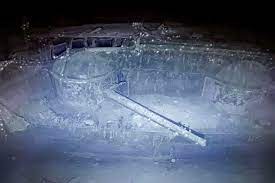First-ever clear footage of the World War II aircraft carriers destroyed in the crucial Battle of Midway
As the first in-depth look at three World War II aircraft carriers that perished in the crucial Battle of Midway, footage from deep inside the Pacific Ocean may help shed light on the mystery surrounding the days-long onslaught that signaled the transfer of power from Japanese to American forces in the Pacific theater.
Two of the four Imperial Japanese Navy aircraft carriers slain during the conflict in June 1942 were the Akagi and the Kaga, which were extensively surveyed in September by remote submersibles working 3 miles (4.8 kilometers) below the surface. The U.S.S. Yorktown was also surveyed.
The Akagi is identified in the high-quality film, which also offers fresh hints regarding the aircraft carriers’ last moments.
The video demonstrates how intense heat destroyed the island, or the towering structure that rose above the wooden deck of the Yorktown, and how the crew went to considerable measures to prevent the American ship from sunking.
One of the last surviving Yorktown soldiers, Julian Hodges, wept as he watched. Hodges had to swim six hours to a rescue ship while carrying a dislocated shoulder.
Only a few weeks away from turning 101, Hodges said, “Boy, she took a beating.” Simply said, “I just hated to see my ship torn up like that.”
The Yorktown and the Japanese ships were discovered four years prior to the discovery of the other two aircraft carriers. However, only a preliminary identification of the Akagi was made, and only scant photos of the other two were captured.
This changed after a month-long exploration of the Papahanaumokuakea Marine National Monument in the Northwestern Hawaiian Islands, about 1,300 miles (2,092 kilometers) northwest of Honolulu, by the Ocean Exploration Trust, which was founded by Bob Ballard, who led teams that discovered the Yorktown and the Titanic.
“We were able to spend over basically three full days on these sites, including two full days on the seafloor, really methodically and thoroughly documenting the entire wrecks,” Daniel Wagner, the chief scientist for Ocean Exploration Trust, said via videoconference from the exploration vessel Nautilus.
More than 100 scientists, historians, and other specialists from across the globe were able to participate in a live forum while on board the Nautilus since the surveys were broadcast online.
Six months after the Japanese assault on Pearl Harbor on December 7, 1941, the Battle of Midway took place. In a surprise assault at Midway Atoll, a small collection of islands about midway between the U.S. Mainland and Asia, the Japanese navy sought to seize control of the U.S. Patrol aircraft station. Additionally, the nation desired to obliterate what remained of the American Pacific Fleet.
However, American forces caught the attack’s communications and were prepared.
About 200 miles (322 kilometers) outside the group of islands, a five-day combat took place. U.S. Forces shot down more than 250 Japanese aircraft in addition to sinking the Akagi, the Kaga, and two additional Japanese aircraft carriers. Over 3,000 Japanese troops lost their lives.
More than 300 military members, around 150 aircraft, and the Yorktown, which was damaged in the engagement and destroyed by a Japanese submarine while being towed for repairs, were among the U.S. losses.
According to Michael Leggins, president of the U.S.S. Yorktown CV-5 Club, a club devoted to disseminating knowledge about the ship, just two of the roughly 4,600 men who served aboard the Yorktown from 1937 to 1942 are thought to be living today.
Hodges, a former Baptist pastor from Johnson City, Tennessee, is one of them. He enlisted in the Navy the day after Pearl Harbor and spent the conflict working in the Yorktown’s boiler room.
In a videoconference interview with the AP, he detailed how, after two torpedoes burst, he was trapped between two pipes with his left arm so firmly pinned that he was unable to free himself. Additionally, he dislocated his shoulder, which is still bothering him 81 years later.
A life jacket was wrapped over his damaged shoulder after he was released with the aid of another seaman, and he then grabbed on to another to swim more than 3 miles (4.8 kilometers) to a waiting ship. He said that the trip took about six hours.
On September 12, 1941, at the age of 17, Robert Taylor, the other surviving Yorktown veteran, required parental consent to enlist in the Navy. During the conflict, Taylor, who is now 99, operated an anti-aircraft gun.
Historians were aware that the crew had thrown off several of the smaller anti-aircraft weapons on the port side in an effort to keep the ship afloat. But according to Hans Van Tilburg, the marine archaeologist and historian for the National Oceanic and Atmospheric Administration’s Office of National Marine Sanctuaries, one of the revelations from the new footage was that the sailors also hacked out the bigger weapons.
“Speaks to the dedication of the crew to save their vessel in the last and final moments of that ship’s service,” he said of the move.
When told to leave the ship, Taylor went overboard and attempted to swim to the adjacent U.S.S. Balch while lending his life jacket to a fellow seaman who couldn’t swim.
However, the ship began to depart as he got closer to the Balch to pick up more soldiers in the sea. Taylor said he caught a line thrown by a crew member with his foot. He was dragged onboard the ship after approaching it, but he doesn’t recall much of what happened afterwards.
From his house in Auburndale, Florida, he told the AP, “They tell me I was screaming.” He had post-traumatic stress disorder after the experience.
The ships will stay where they are now, in U.S.-protected seas, which should keep them from being vandalized or turning into a tourist attraction like the Titanic.
Wagner said that the only items removed from the accidents would be the photos and videos they share.
Hodges said he was grateful for it. “Nobody’s going to get anything out of it,” he said.
With the help of the film, he intends to inspire a younger generation to reflect on the costs of war: “Whatever it takes to put wars out of business.”
Taylor joked that he would want the ship resurrected, if only so he could get back the USD 28 (or roughly USD 530 in today’s currency) he left in his locker when the ship went down.
Despite his humor, he is troubled by the Yorktown’s demise. Taylor remarked, “I liked that ship, so I was pretty disappointed. To sink it, a lot was required.







